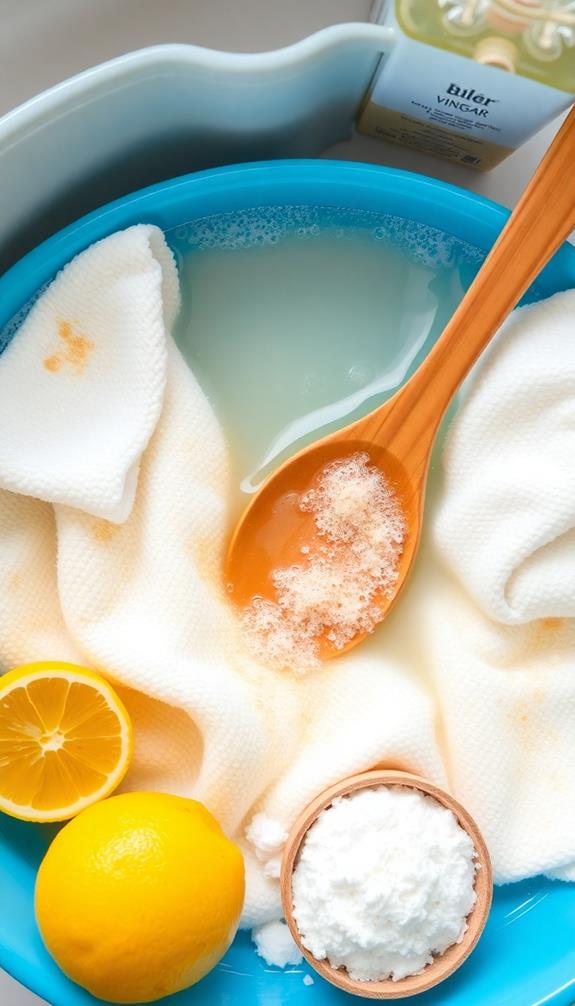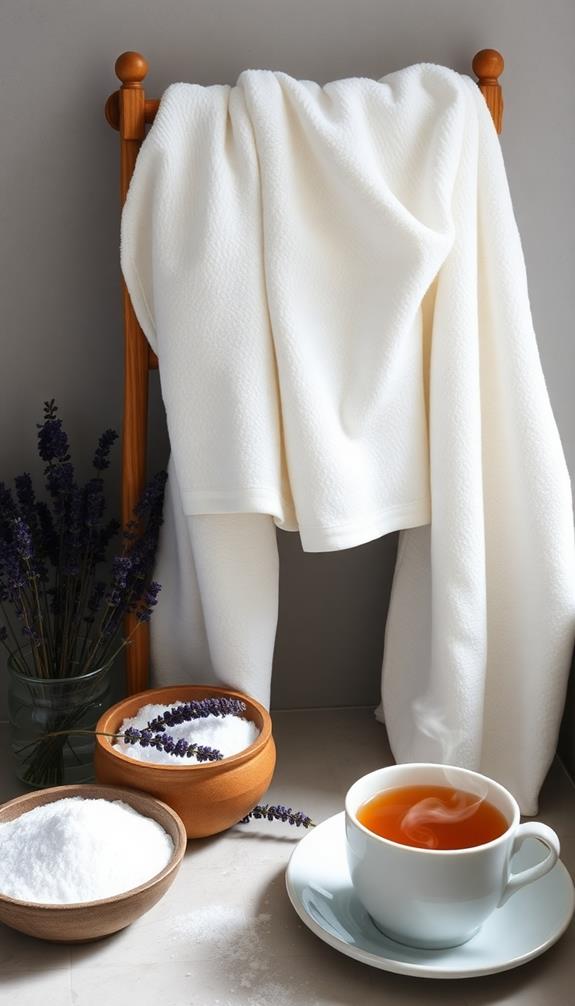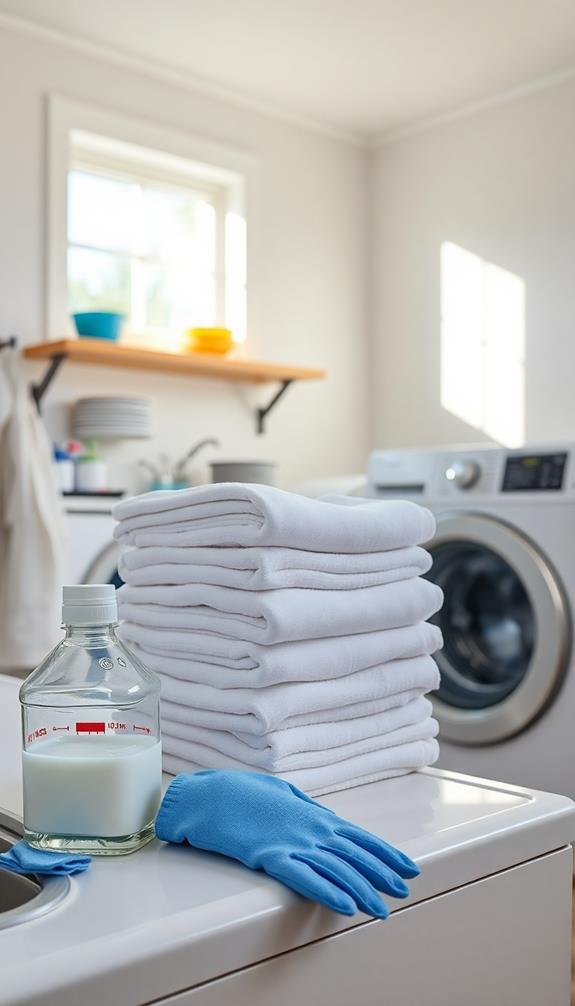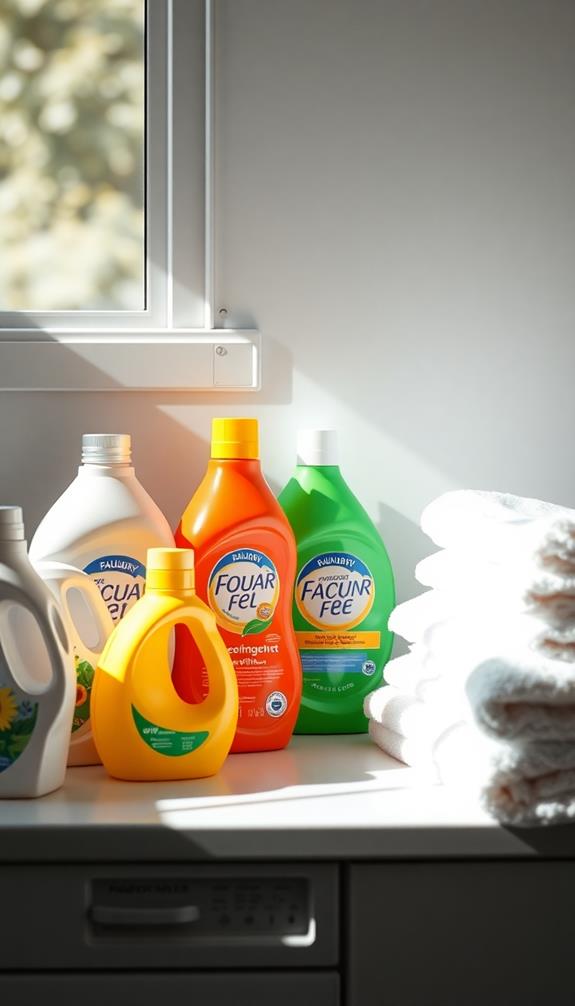To whiten your towels effectively, start by washing them in hot water, as it removes dirt and stains efficiently. Add 1/2 cup of baking soda or 2 tablespoons of white vinegar to boost cleaning power. Don't forget to use oxygen bleach in every wash to prevent yellowing. If stains are stubborn, treat them before washing. Aim to wash towels every few days, and avoid fabric softeners to maintain their softness. After washing, shake the towels before drying to fluff the fibers. To achieve the best results, follow these tips, and uncover even more strategies to keep your towels bright and fresh.
Keeping Towels White and Soft
To keep your towels white and soft, regularly use oxygen bleach, like Oxiclean White Revive, in every wash. This helps prevent yellowing and maintains the brightness of your white towels.
Efficient laundry routines emphasize washing towels in the hottest water setting suitable for the fabric to effectively eliminate dirt and yellow tones.
Additionally, enhance the cleaning power by adding 1/2 cup of baking soda or 2 tablespoons of distilled white vinegar to the wash cycle. These natural additives not only boost cleaning but also improve softness without leaving any residue behind.
After washing, shake your towels before placing them in the dryer. This simple step helps fluff the fibers, promoting greater softness and absorbency.
While fabric softeners might seem like a good idea, limit their use as they can create buildup that leads to stiffness, compromising your towels' fluffiness.
Effective Washing Techniques
Maintaining the brightness and softness of your towels goes hand in hand with effective washing techniques. Start by washing your white towels in the hottest water setting suitable for the fabric. This helps eliminate dirt and yellow tones that can dull their appearance.
To enhance the cleaning process, add ½ cup of baking soda or 2 tablespoons of distilled white vinegar to the wash. These simple cleaning hacks can make a significant difference in keeping your towels fresh and soft. Additionally, be sure to follow care label instructions, as they provide crucial information on water temperature and detergent type.
While you might be tempted to use fabric softeners, try to limit their use. Over time, they can cause buildup that leads to stiffness in your towels, making them less pleasant to use.
It's also important to regularly wash your towels every few days to prevent odor buildup and maintain their overall appearance.
After washing, give your towels a good shake before placing them in the dryer. This action helps fluff the fibers, ensuring your towels remain soft and cozy.
Stain Removal Methods

Stain Removal Methods
How can you effectively tackle stubborn stains on your towels? Stains can be a hassle, but with the right methods, you can restore your towels to their pristine condition. Here are some effective stain removal techniques to weigh:
- Makeup Stains: Spray a pretreating cleaner directly on the stain before washing. This helps break down the residue effectively. For an eco-friendly approach, you can also try using natural ingredients like vinegar or baking soda to treat stubborn makeup stains.
- Perspiration Stains: Apply a prewash stain remover and wash in hot water with fabric-safe bleach for best results. Additionally, utilizing lemon juice can help with any yellowing caused by sweat stains.
- Drink Stains: For spills like wine or coffee, soak the towel in cold water, then pretreat with a stain remover before laundering. This method helps prevent the stains from setting deeply into the fabric.
Always remember to launder stained towels with appropriate cleaning agents and avoid drying them until you've completely removed the stains. Heat can set stains and make them harder to eliminate.
Odor Elimination Strategies
Odors can be a persistent problem with towels, especially after repeated use. To tackle this issue, you can use simple, effective strategies that incorporate baking soda and white vinegar.
Start by adding ½ cup of baking soda or white vinegar to the wash cycle. Both ingredients are great at neutralizing unpleasant smells, and key natural ingredients for stain removal can enhance the freshness of your towels.
For an extra odor-fighting boost, consider incorporating white vinegar during the final rinse cycle. It acts as a natural fabric softener while helping to eliminate any lingering odors.
It's also essential to wash your towels every few days to prevent odor buildup, keeping them smelling fresh.
After washing, make sure to dry your towels completely. Damp towels can lead to mildew, which exacerbates unpleasant smells.
If you notice an odor before washing, sprinkle baking soda over the towels and let it sit for a while. This helps absorb odors and enhances their overall freshness.
Soften Your Towels Naturally

After tackling odors, you'll want your towels to feel soft and inviting. You can achieve this naturally without resorting to chemical fabric softeners, which often leave a waxy buildup that reduces absorbency over time.
Utilizing natural ingredients like vinegar can't only soften your towels but also promote eco-friendly cleaning practices non-toxic cleaners. Here are three effective methods to soften your towels:
- Use Vinegar: Add ½ cup of white distilled vinegar during the final rinse cycle. This helps break down any detergent residue and naturally softens your towels.
- Fluff in the Dryer: Before drying, shake out your towels to fluff them up. This prevents clumping of fibers, helping maintain their softness.
- Tennis Balls Trick: Toss a couple of clean tennis balls in the dryer with your towels. They'll help agitate the fabric, ensuring your towels stay fluffy and soft while they tumble dry.
Additionally, consider washing your towels regularly with hot water. This not only cleans them effectively but also contributes to their long-term softness by breaking down residues.
Safe Bleaching Practices
Bleaching your towels can effectively restore their whiteness, but it's important to do it safely to avoid damaging the fabric. To start, always dilute bleach before adding it to the washing machine. A safe mixture is ½ cup (120 mL) of bleach with 1 quart (950 mL) of water. This dilution helps minimize any potential harm to your towels, just as cleaning with vinegar can maintain the freshness of your laundry.
When you're ready to use bleach, make certain to use the bleach dispenser in your washing machine, if available. This guarantees an even distribution and prevents direct contact with the fabric, which can cause damage.
Also, be cautious not to over-soak your towels or use excessive bleach, as both can lead to deterioration and yellowing.
Always follow the instructions on the bleach package carefully. Proper usage according to these guidelines is essential in maintaining the whiteness of your towels while preventing any unwanted effects.
Avoid applying undiluted bleach directly to the towels, as this can ruin them. By practicing these safe bleaching methods, you can enjoy bright, fresh towels without compromising their quality.
Step-by-Step Bleaching Guide

To get your towels ready for bleaching, start by loading them into the washing machine without overcrowding.
It's also helpful to guarantee your towels are clean and free from any fabric softeners, as these can interfere with the bleaching process.
Next, you'll want to focus on proper bleach dilution techniques to protect the fabric while maximizing whitening.
For best results, consider using a mild dish soap and water solution when preparing your towels.
Preparing Towels for Bleaching
Preparing your towels for bleaching starts with checking the care labels to verify they're bleach-safe. Once you've confirmed that your towels can handle bleach, gather the necessary supplies. You'll need non-chlorine bleach, a measuring cup, and a washing machine capable of using hot water.
Follow these steps to prepare your towels effectively:
- Dilute the Bleach: Mix ½ cup (120 mL) of non-chlorine bleach in 1 quart (950 mL) of water. This dilution guarantees even distribution and minimizes fabric damage.
- Load the Washer: Place your towels in the washing machine without overcrowding. This allows enough space for effective cleaning and agitation during the wash cycle.
- Add Bleach: Start the wash cycle and wait five minutes before adding your diluted bleach. This timing helps the bleach actively work on your towels.
Once you've completed these steps, let the machine run its full cycle. Doing so will help you achieve the best results when you bleach your white towels, making them look fresh and bright again.
Proper Bleach Dilution Techniques
When you're ready to whiten your towels, it's vital to get the bleach dilution just right for the best results. Start by mixing ½ cup (120 mL) of bleach with 1 quart (950 mL) of water. This ratio guarantees that your bleach dilution is effective and safe for your fabrics.
For High-Efficiency (HE) washers, use the bleach dispenser, which protects your white towels from direct contact with concentrated bleach. If you're using a standard washer, don't overcrowd the load; this allows the bleach to mix properly with the detergent and achieve maximum whitening results.
Once you've prepared the diluted bleach, add it to the washing machine after five minutes of agitation. This step is necessary for even distribution throughout the load, maximizing the whitening effects.
Always remember to follow the manufacturer's instructions on the bleach product to maintain the integrity of your towels.
Post-Bleaching Care Tips
After bleaching your towels, it's vital to take proper care to maintain their brightness and quality. Follow these post-bleaching care tips to keep towels white and fresh:
- Dry Properly: After the bleaching cycle, use the dryer or hang your towels to dry. This helps eliminate any residual bleach odor, ensuring they smell clean and fresh.
- Skip Fabric Softener: Avoid using fabric softener on your bleached towels. While it may seem tempting, it can reduce their absorbency and effectiveness, which is essential for towels.
- Assess Brightness: If your towels aren't as white as you'd like after the first bleaching, don't hesitate to repeat the bleaching cycle. Just make sure to use the bleach solution within 24 hours of mixing for the best results.
Always remember to follow the care instructions on your towels to prevent damage.
Proper post-bleaching care will help you maintain their bright appearance and prolong their lifespan, ensuring your towels remain in top condition for everyday use.
Importance of Hot Water
Hot water plays an essential role in keeping your towels bright and fresh. When you wash your towels in hot water, it dissolves stains and dirt more efficiently than cold water ever could. This enhanced cleaning effectiveness is critical for maintaining the whiteness of your towels.
Furthermore, hot water helps kill germs and bacteria, improving hygiene, especially in household textiles. Regularly disinfecting your towels helps reduce the spread of harmful bacteria and viruses, which is essential for your family's health and well-being, as proper disinfecting is crucial in preventing infections.
By utilizing the hottest water setting suitable for your towel fabric, you can markedly reduce yellowing and discoloration over time. Regularly washing your towels in hot water not only keeps them looking vibrant but also extends their lifespan.
It's particularly beneficial for tackling stubborn stains and lingering odors, making it a critical component of your towel cleaning process.
Choosing the Right Detergent

Choosing the right detergent is essential for maintaining the brightness and cleanliness of your towels. A good detergent not only cleans but also guarantees your white towels stay soft and absorbent.
Here's what you should consider when picking your detergent:
- HE Detergent: If you have a high-efficiency washer, use HE detergent. It's formulated to produce fewer suds, enhancing cleaning efficiency.
- Enzymes and Optical Whiteners: Look for detergents that contain enzymes and optical whiteners. These ingredients help break down stains and improve the brightness of your white towels.
- Avoid Bleach on Delicates: While it might be tempting to use bleach for whitening, avoid it on delicate fabrics like wool or silk. Bleach can damage these materials, so always check the care label.
Always follow the manufacturer's recommendations for the best detergent type and dosage to achieve superior washing results.
Maintenance Tips for Longevity
To keep your white towels looking fresh, establish a regular washing schedule every few days.
Proper storage techniques, like keeping them in a dry, well-ventilated area, also play an essential role in their longevity.
Regular Washing Schedule
While keeping your towels clean might seem like a chore, establishing a regular washing schedule is crucial for maintaining their brightness and freshness. By washing your towels every few days, you prevent dirt buildup and extend their lifespan.
Here's how to guarantee your towels stay white and vibrant:
- Use Hot Water: Always wash your towels in hot water. It effectively dissolves stains and dirt, promoting overall cleanliness.
- Bleach EVERY TIME: Incorporate oxygen bleach in every wash cycle to prevent yellowing and maintain the brightness of your white towels.
- Avoid Mixing Colors: Never mix white towels with colored laundry. This helps avoid dye transfer that can lead to unwanted discoloration.
After washing, remember to shake your towels before tossing them in the dryer. This simple step fluffs the fibers, keeping your towels soft and absorbent.
By sticking to this regular washing schedule, you'll not only keep towels in pristine condition but also make sure they look fresh and inviting every time you reach for them.
Consistency is key to preserving their whiteness and extending their life!
Proper Storage Techniques
Properly storing your towels is essential for keeping them fresh and fluffy, especially since dampness can lead to mildew and odors. To maintain the quality of your towels and sheets, choose a cool, dry place for storage, steering clear of humid areas like bathrooms.
Instead, opt for breathable storage bins or baskets that allow air circulation; this helps reduce moisture buildup and keeps odors at bay.
When you fold your towels, do it neatly to minimize creasing and preserve that fluffy texture you love. Avoid stacking towels too tightly; leaving some space between them promotes airflow and prevents mustiness.
Regularly check your stored towels for any signs of dampness or unpleasant smells. If you notice any issues, wash them promptly to guarantee their longevity.
Conclusion
So, there you have it—keeping your towels pristine is a piece of cake, right? Just toss 'em in the wash with some hot water and the right detergent, and voila! But let's be honest, it takes a bit more finesse than that. With a bit of effort and these steps, you'll have towels that not only look white but feel soft, too. Who knew achieving that spa-like experience at home could be so… surprisingly complicated?